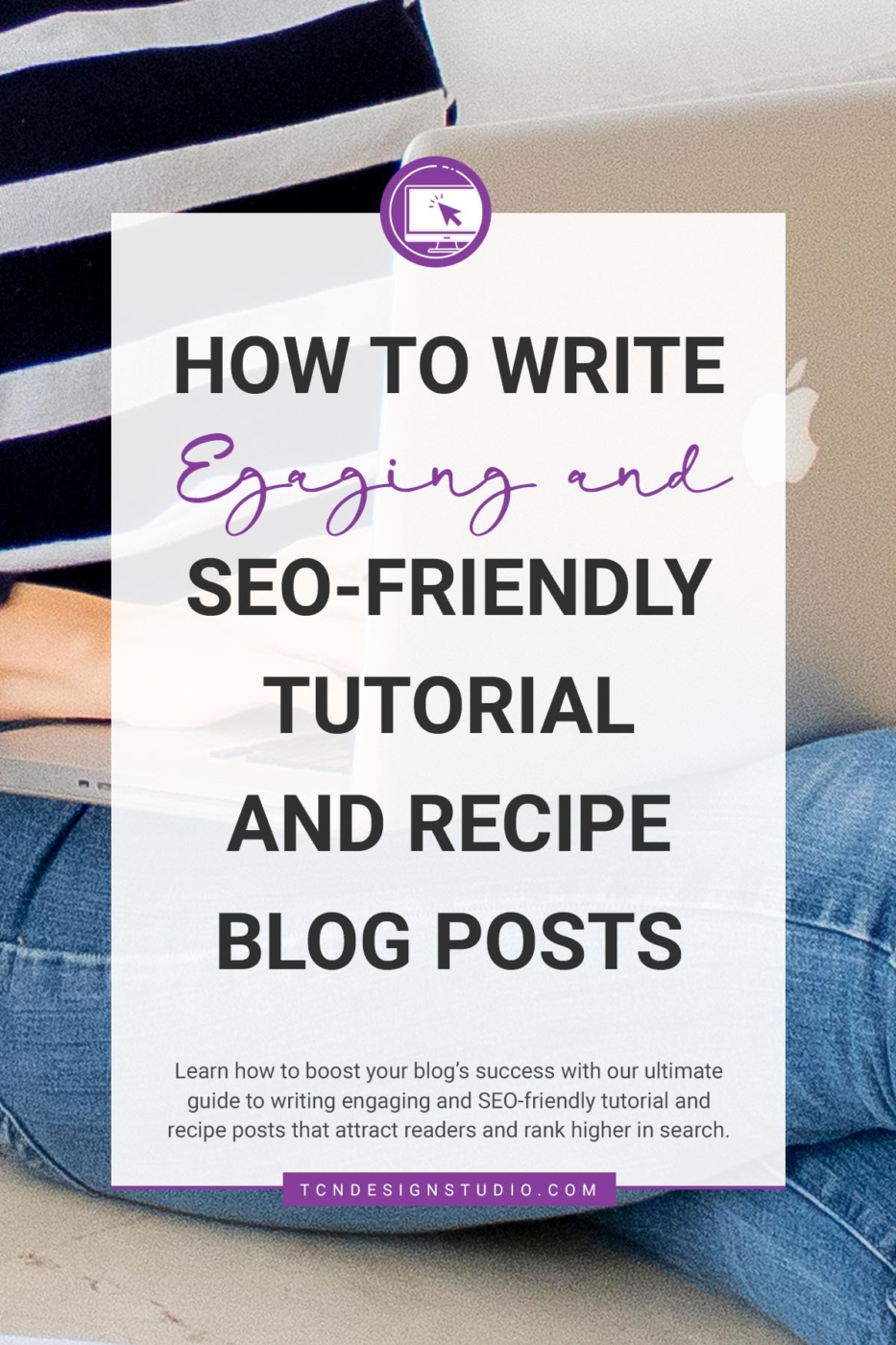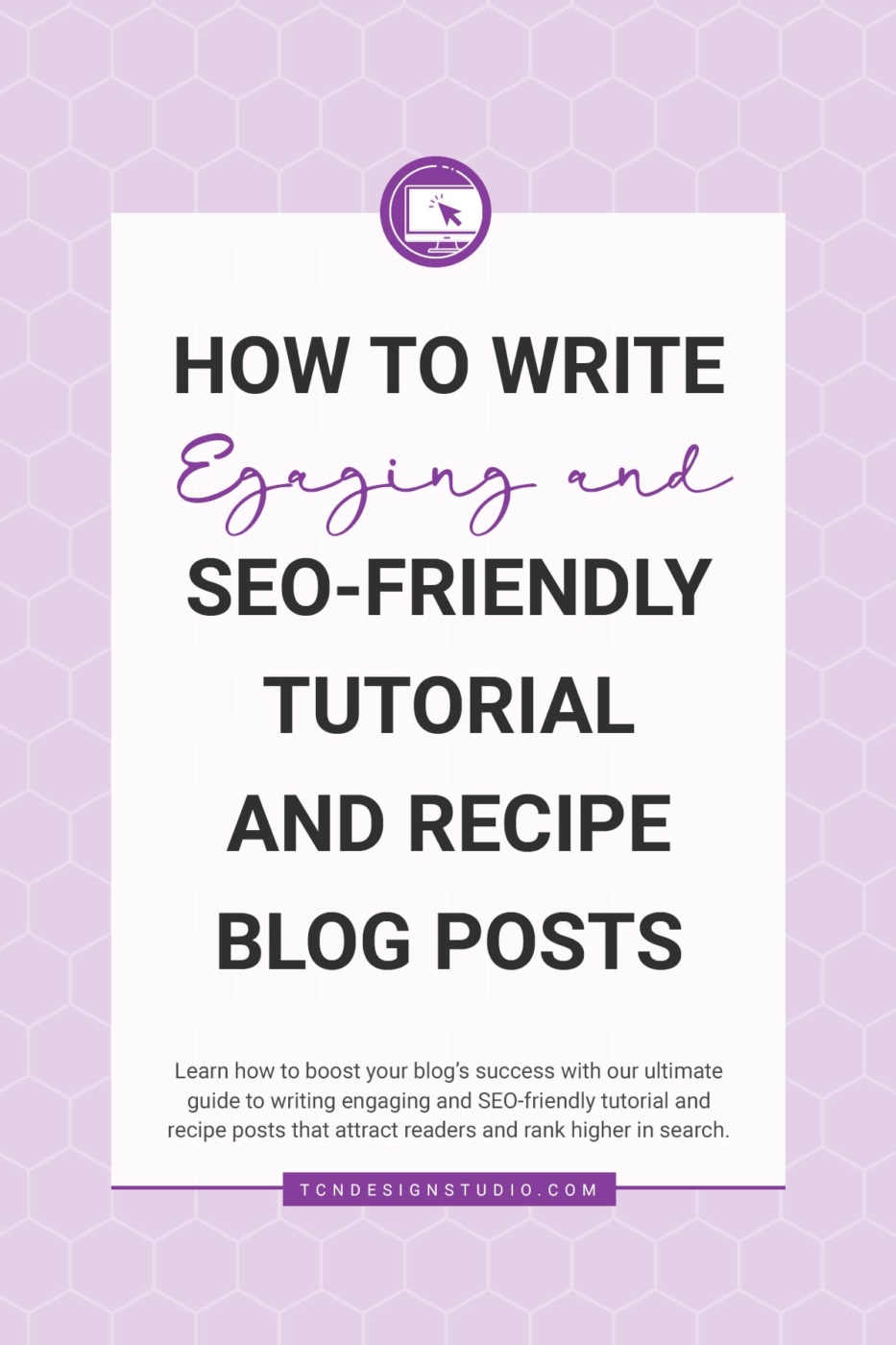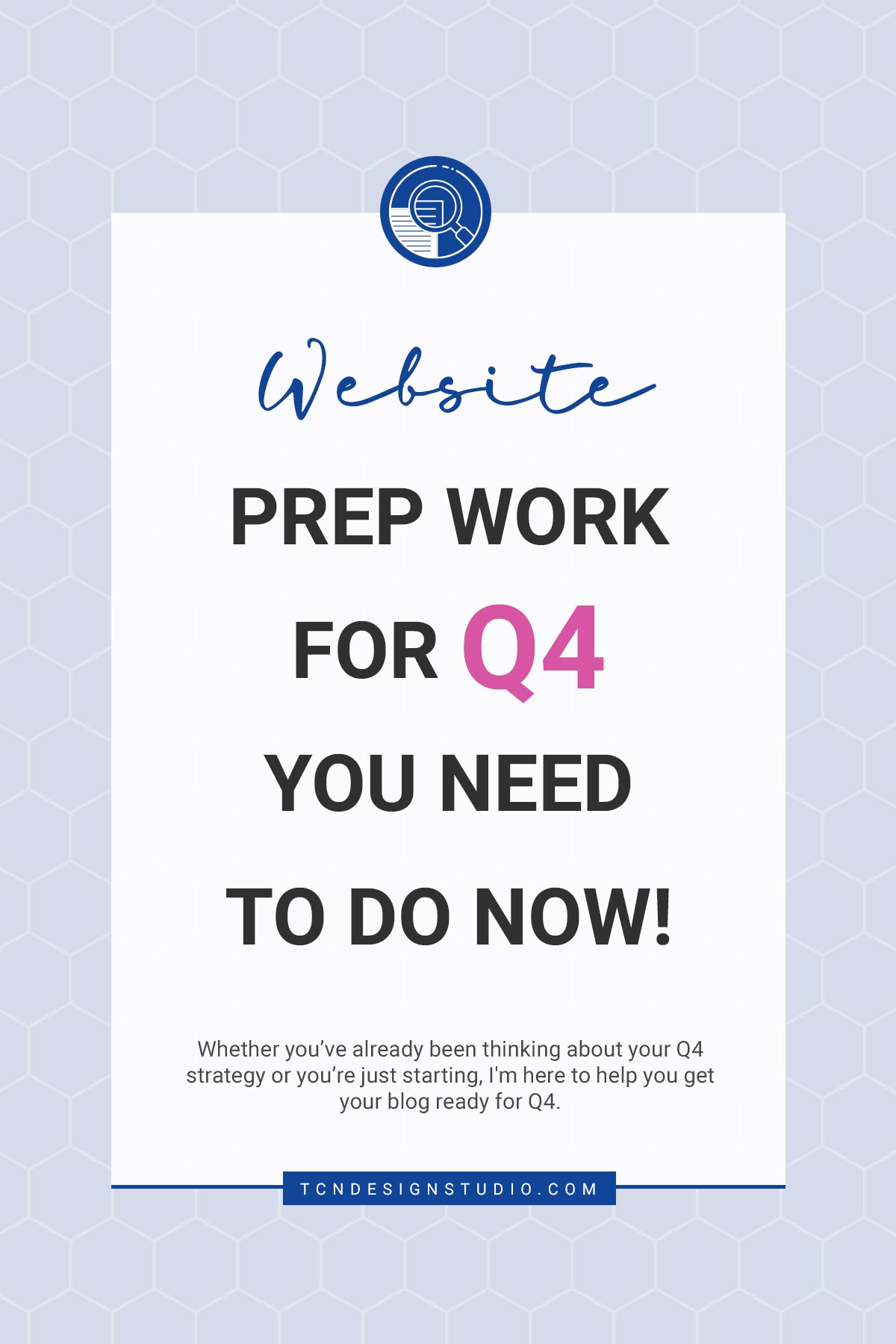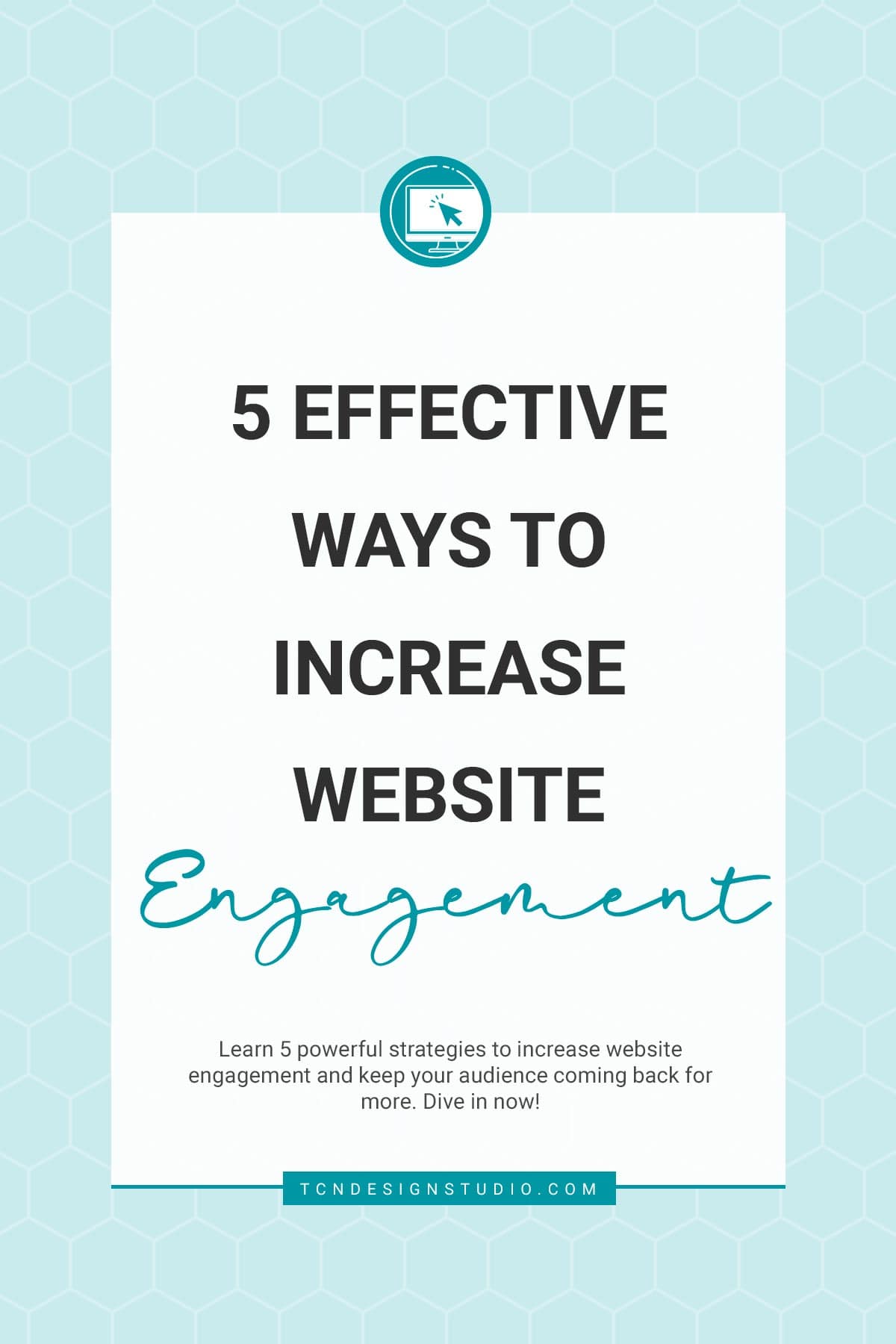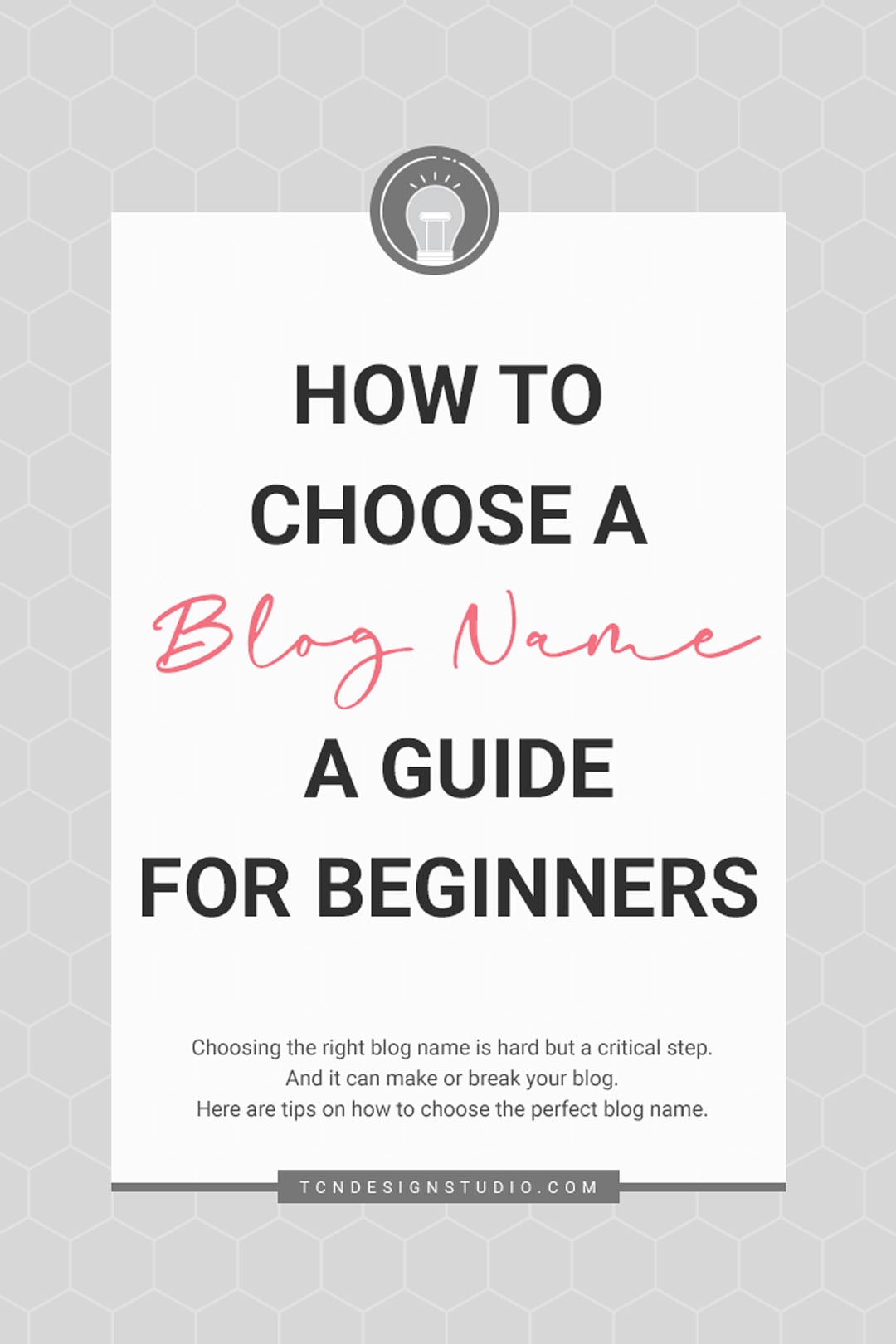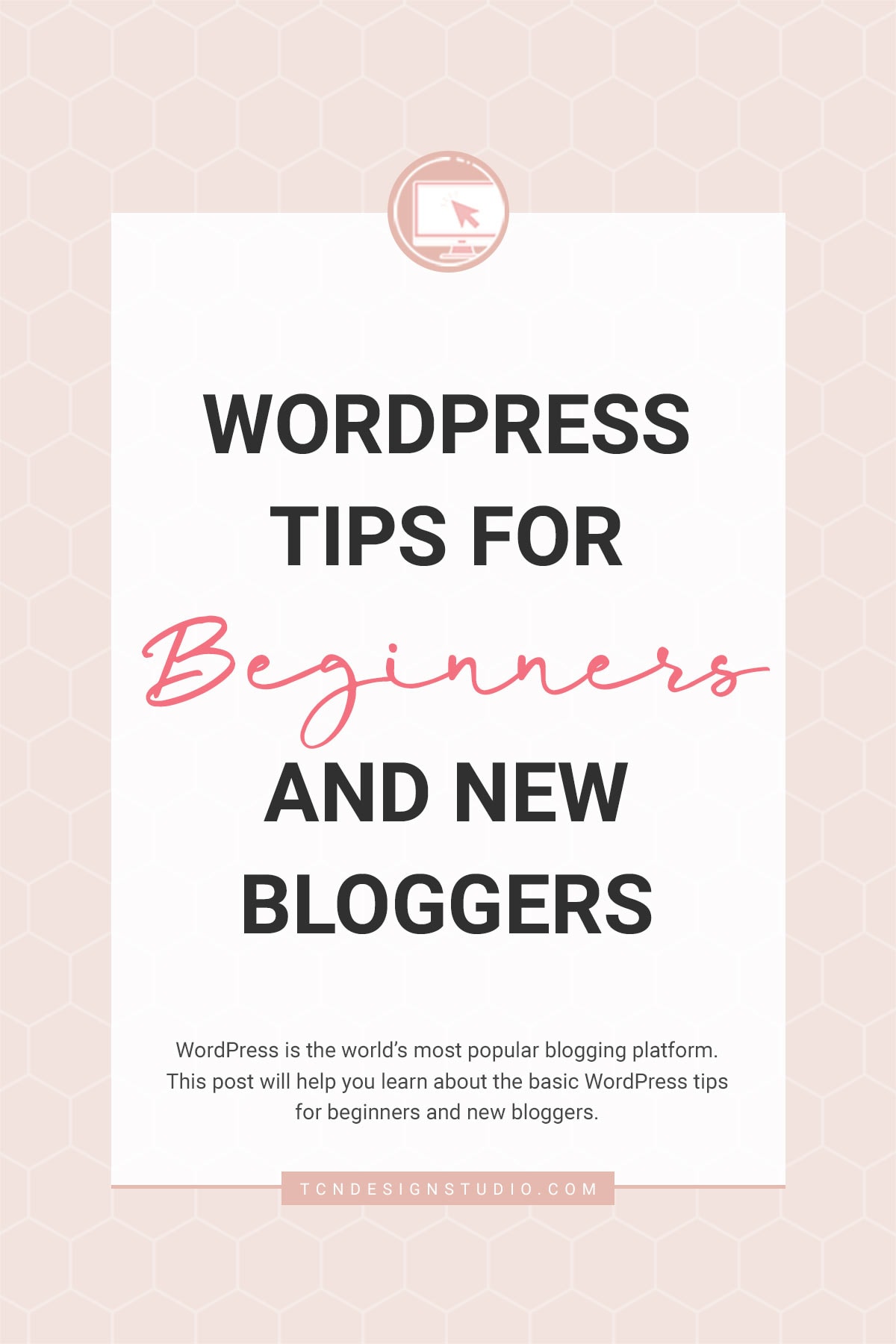The Ultimate Guide to Writing Engaging and SEO-Friendly Tutorial and Recipe Posts
Boost your blog’s success with our ultimate guide to writing engaging and SEO-friendly tutorial and recipe posts that attract readers and rank higher in search.
Crafting the perfect tutorial or recipe post that not only captures your reader’s attention but also ranks well on search engines is both an art and a science.
Whether you’re a seasoned blogger or just starting out and you’re walking readers through a DIY project or guiding them through a delicious recipe, the goal is the same: provide clear, actionable steps that are easy to follow and keep your audience engaged from start to finish, love it and return to again and again.
With over a decade of blogging experience, I’ve learned that the secret sauce to a successful blog post is striking the perfect balance between engaging content and solid SEO practices.

Understanding Your Audience
Before you start writing, it’s crucial to understand who you’re writing for. Understanding who you’re writing for will guide every decision you make. Knowing your audience will guide your tone, the level of detail you provide, and even the types of tutorials or recipes you choose to share.
1. Identify Your Ideal Reader
- Demographics: Consider age, gender, location, and occupation. For example, if your blog targets stay-at-home moms interested in DIY projects, you’ll want to use a friendly, conversational tone and include step-by-step tutorials with lots of visuals. If you’re targeting busy moms, your recipes might focus on quick, easy meals or your tutorials might highlight simple, time-saving DIY projects.
- Interests and Pain Points: What challenges does your reader face? What are they passionate about? Knowing this helps you craft content that resonates with them. Are they looking for budget-friendly home decor ideas or quick weeknight dinners? Your posts should provide solutions to these specific needs.
2. Create Reader Personas
Develop detailed personas that represent your ideal readers. For example, “Sarah is a 35-year-old mom who loves crafting and is always looking for easy, budget-friendly DIY projects.” Or maybe “Emma is a 30-year-old mom who loves cooking healthy meals for her family but has limited time during the week.” Use these personas to guide your content creation, ensuring each post speaks directly to one of these characters.
3. Conduct Audience Research
Use tools like Google Analytics, social media insights, and surveys to gather data about your audience. Look at which posts are getting the most engagement and traffic. This data will help you understand what your readers are interested in and what kind of content keeps them coming back.
Choosing the Right Topic: Solving Problems and Adding Value
Once you know your audience, the next step is to choose a topic that will engage them. The best blog posts solve a problem, answer a question, or provide value in some way.
1. Use Keyword Research to Find Popular Topics
- Keyword Research Tools: Use tools like Google Keyword Planner, Keysearch, Ahrefs, or SEMrush to find keywords that your audience is searching for. Look for keywords with a good balance of search volume and competition.
- Long-Tail Keywords: Focus on long-tail keywords (phrases of 3-5 words) that are more specific and less competitive. For example, instead of targeting “DIY crafts,” go for “easy DIY crafts for kids” or “DIY Christmas crafts on a budget”, “Easy DIY Christmas ornaments” or “quick vegan weeknight dinners.”
- Seasonal Relevance: Consider the time of year and upcoming holidays. Seasonal posts like “DIY Halloween costumes” or “Thanksgiving side dishes” often perform well.
2. Solve Common Problems
Think about the common challenges your readers face and create content that provides clear, actionable solutions. For example, if your readers struggle with meal prep, a post like “How to Meal Prep for a Week in Under 2 Hours” could be a hit.
3. Monitor Trends in Your Niche
Stay updated on trends within your niche by following industry leaders, reading relevant blogs, and using tools like Google Trends. Write about timely topics that your audience cares about now.
4. Answer Common Questions
Visit forums like Quora, Reddit, Answer the People, or niche-specific Facebook groups to see what questions your audience is asking. Create blog posts that answer these questions in detail.

Crafting a Compelling Headline
Your headline is the first thing readers see, and it often determines whether they’ll click on your post or scroll past it. A compelling headline is both attention-grabbing and descriptive.
1. Incorporate Your Main Keyword
Ensure your main keyword appears in the headline. This not only helps with SEO but also makes it clear what the post is about. For example, if your keyword is “SEO tips,” a headline might be “10 Essential SEO Tips Every Blogger Should Know.”
2. Use Power Words when possible
Words like “ultimate,” “essential,” “proven,” and “effective” add impact to your headline. They suggest that your post contains valuable, actionable information.
3. Be Specific and Promise Value
Specificity and value are key. Instead of “SEO Tips for Bloggers,” a better headline might be “10 Proven SEO Tips to Skyrocket Your Blog Traffic in 2024.”
4. Test Different Headlines
If you’re unsure about your headline, use tools like CoSchedule’s Headline Analyzer or run A/B tests to see which headline performs better.
Structuring Your Blog Post: The Importance of Readability
A well-structured blog post not only helps your readers digest information easily but also improves your SEO by making your content easier for search engines to index.
1. Start with a Catchy Introduction
- Hook Your Readers: Start with a brief introduction that hooks your readers. Share a personal story, highlight the benefits of the tutorial or recipe, or pose a question that piques their interest.
- Set Expectations: Clearly state what the reader will learn or accomplish by the end of the post. This sets the stage and lets them know they’re in the right place.
1. Use Short Paragraphs and Sentences
Break up your text into short paragraphs (2-3 sentences each) and use short sentences where possible. This improves readability, especially for mobile users.
2. Utilize Subheadings
Subheadings (H2, H3, etc.) help organize your content and make it easier for readers to skim through the post. They also provide SEO benefits by indicating the structure of your content to search engines.
3. Incorporate Bullet Points and Numbered Lists
Bullet points and numbered lists make your content scannable and highlight key points. They’re particularly effective for step-by-step guides and list-based posts.
3. Use a Step-by-Step Format
- Subheadings for Each Step: Break down your tutorial or recipe into clear, manageable steps. Use subheadings (H3, H4) for each step to guide readers through the process.
- Numbered Steps: Numbering each step makes it easier for readers to follow along, especially if they need to refer back to a specific part of the post.
4. Writing Clear and Engaging Instructions
Your instructions are the heart of your post. They need to be clear, concise, and engaging to keep readers on track and motivated to complete the project or recipe.
A. Use Simple, Direct Language
- Be Concise: Get straight to the point with your instructions. Avoid unnecessary jargon or overly complex language.
- Be Specific: Provide exact measurements, times, and details. Instead of saying “cook for a while,” specify “cook for 10 minutes, or until golden brown.”
B. Anticipate Questions and Address Them
- Include Tips and Notes: Anticipate any challenges or common questions your readers might have and address them within the instructions. For example, “If your dough is too sticky, add a tablespoon of flour.”
- Offer Alternatives: Provide alternatives for ingredients or steps where applicable. For instance, “If you don’t have almond flour, you can substitute with oat flour.”
C. Keep the Reader Engaged
- Use a Conversational Tone: Write as if you’re guiding a friend through the process. This makes your post more relatable and enjoyable to read.
- Encourage Interaction: Ask questions or encourage readers to share their results in the comments. This not only boosts engagement but also builds a sense of community around your content.
5. Include Visuals
Use images, infographics, and videos to break up text and make your content more engaging. Visuals not only help illustrate your points but also improve time on page—a key SEO factor.
- Photos for Each Step: Visuals are crucial in both tutorials and recipes. Include high-quality photos for each step to illustrate what you’re describing. This helps visual learners and makes your post more engaging.
- Videos: If possible, include a video tutorial. Videos can significantly increase engagement and help clarify complex steps.
6. Use Internal and External Links
- Internal Links: Link to other relevant posts on your blog to keep readers engaged, improve your site’s SEO, and help search engines understand the structure of your site.
- External Links: Link to authoritative sources that back up your points. This not only adds credibility but also signals to search engines that your content is well-researched. Link to reputable external sources to provide additional value and context to your readers. This can also boost your SEO by associating your content with high-quality websites.
Keeping Readers Hooked Writing Engaging Content
Engagement is about more than just getting clicks—it’s about keeping readers on your page, encouraging them to interact with your content, and prompting them to take action.

1. Write in a Conversational Tone
Use a friendly, conversational tone that reflects your brand’s personality. Write as if you’re speaking directly to your reader, using “you” and “your” to create a personal connection.
2. Tell Stories
Incorporate storytelling into your posts to make them more relatable and memorable. Share personal experiences, case studies, or hypothetical scenarios that illustrate your points.
3. Ask Questions
Engage your readers by asking questions throughout your post. This not only encourages interaction but also keeps them thinking and engaged.
4. Provide Actionable Takeaways
Make sure your readers walk away with something they can immediately apply. Whether it’s a step-by-step guide, a list of tools, or a set of tips, actionable content is what keeps readers coming back.
5. Encourage Comments and Interaction
End your posts with a question or call to action that invites readers to comment or share their thoughts. This not only boosts engagement but also provides you with valuable feedback and ideas for future posts.
Getting Your Content Seen Optimizing for SEO
SEO is what helps your engaging content get found. Without proper optimization, even the most well-written posts can go unnoticed.
1. Optimize Your Meta Title and Description
Your meta title should include your main keyword and be compelling enough to entice clicks. The meta description, though not a ranking factor, should give a brief summary of the post and encourage readers to click through.
- Include Your Main Keyword: Make sure your primary keyword is in the title and meta description. This helps search engines understand what your post is about.
- Make It Enticing: Your title should be compelling and your meta description should clearly summarize the post, encouraging users to click.
2. Use Keywords Naturally
Sprinkle your main keyword and related keywords throughout your post, but don’t overdo it. Focus on writing naturally and ensuring that your keywords fit smoothly into the content.
- Keyword Placement: Include your primary keyword in the first 100-150 words, in subheadings, and throughout the content where it fits naturally. Avoid keyword stuffing, which can hurt readability and SEO.
- Related Keywords: Use related keywords and phrases to give your content more context and improve your chances of ranking for multiple search terms.
3. Optimize Images with Alt Text
Every image should have an alt text that describes the image and includes your keyword when relevant. This helps with image SEO and ensures your content is accessible to all readers.
- Alt Text: Use descriptive alt text for your images that include relevant keywords. This helps with both accessibility and image search rankings.
- File Names: Name your image files with descriptive, keyword-rich names instead of generic ones like “IMG_1234.jpg.”
4. Improve Page Load Speed
Slow-loading pages can hurt your SEO and frustrate readers. Optimize your images, use a caching plugin, and choose a reliable hosting service to ensure your pages load quickly.
5. Ensure Mobile-Friendliness
With more people browsing on mobile devices, it’s crucial that your blog is fully responsive. Use a mobile-friendly theme and test your posts on different devices to ensure they look great everywhere.
Promoting Your Blog Post
Even the best content won’t get seen without promotion. Here’s how to ensure your post reaches as many eyes as possible:
Share your post across all your social media platforms. Use eye-catching images, relevant hashtags, and engaging captions to draw attention.
- Platform-Specific Promotion: Share your post across all relevant social media platforms. Tailor your message to fit each platform’s audience. For example, use engaging visuals on Instagram, detailed descriptions on Pinterest, and conversational snippets on Facebook.
- Use Hashtags: Use relevant hashtags to increase your post’s visibility on platforms like Instagram and Twitter.
2. Email Your List
Notify your email subscribers about your new post. Write a compelling email that teases the content and includes a clear call-to-action encouraging them to read and share.
- Newsletter Feature: Include your new post in your next email newsletter with a brief teaser that entices subscribers to click through and read the full post.
- Personalized Messaging: Segment your email list if possible and tailor the message to different groups (e.g., DIY enthusiasts vs. food lovers).
3. Engage in Communities
Share your post in relevant online communities like Facebook groups, Reddit threads, and forums. Be sure to follow community guidelines and add value to the conversation rather than just promoting.
4. Leverage SEO
Optimize your post for search engines from the start. Over time, as your post ranks higher, it will attract organic traffic without additional promotion.
5. Repurpose Content
Turn your blog post into different formats like infographics, videos, or podcast episodes to reach a wider audience. Share these across different platforms to maximize exposure.

Monitoring Performance–Learning and Improving
After publishing your post, the work isn’t over. Monitoring how your post performs is crucial for understanding what works and what doesn’t, so you can improve future content.
1. Track Key Metrics
- Google Analytics: Use Google Analytics to monitor key metrics like page views, bounce rate, average time on page, and conversion rates. This data can help you understand how well your post is performing and where you might need to make adjustments.
- Social Engagement: Pay attention to how your post is performing on social media. Are people sharing it? Commenting? These are good indicators of engagement.
2. Monitor SEO Performance
Use tools like Google Search Console to monitor your post’s ranking on search engines. Check which keywords it’s ranking for and make adjustments as needed.
3. Engage with Readers
Respond to comments on your blog and social media, and encourage further discussion. This not only boosts engagement but also builds a community around your content.
4. Update Content Regularly
Content can become outdated, especially if it’s tied to trends or specific tools. Regularly update your posts to ensure they remain relevant and valuable to your readers.
- Regular Updates: Update your post as needed to keep it relevant, especially if it’s a seasonal or time-sensitive topic. Adding new information or tips can help improve its performance over time.
- Republish with Enhancements: If a post is performing well, consider republishing it with enhancements like additional images, a video, or an updated introduction. This can breathe new life into older content.
Conclusion
Writing engaging and SEO-friendly blog posts is both an art and a science. It requires a deep understanding of your audience, solid writing skills, and a strategic approach to SEO. But with the right techniques, you can create content that not only captures your readers’ attention but also ranks well in search engines, driving consistent traffic to your blog.
Remember, the key to successful blogging is continuous learning and improvement. Use the tips and strategies in this guide to refine your content creation process, and don’t be afraid to experiment with different approaches. The more you write and optimize, the better your posts will become—and the more your blog will grow.
Need More Help?
Writing great content is just the start—turning your blog into a thriving business takes strategy, focus, and the right support. That’s where I come in!
With over a decade of blogging experience, I offer one-on-one mentorship to help you navigate the challenges of blogging, from boosting traffic to mastering SEO and monetization.
If you’re ready to take your blog to the next level, let’s work together to create a tailored plan that aligns with your goals. Get in touch today to start your journey to blogging success!
Frequently Asked Questions
This question is the source of many debates and arguments. Although it’s said that posts that are 1,500 to 2,500 words tend to perform well in search engines, the ideal length of a blog post can vary depending on the topic, and what really matters is that your content covers the topic in-depth, which is essential for both user engagement and SEO. So in short, focus on quality over quantity—ensure every word adds value and keeps the reader engaged.
Start with keyword research using tools like Google Keyword Planner, Keysearch, Ahrefs, or SEMrush to find keywords relevant to your topic. Look for a balance of search volume and competition. Long-tail keywords (3-5 words) are often easier to rank for and can bring in more targeted traffic. Once you’ve identified your keywords, use them naturally in your title, headings, and throughout the content.
Meta titles and descriptions are crucial for SEO as they are the first thing users see in search engine results. A well-crafted meta title should be concise, include your main keyword, and entice users to click. The meta description should briefly summarize the content and include a call-to-action. Both should be compelling and informative to improve click-through rates.
Internal links help readers navigate your blog and keep them engaged by guiding them to related content, which also helps with SEO by distributing link equity across your site. External links to authoritative sources add credibility to your post and show search engines that you’re providing well-researched content. Aim to include a mix of both in your blog posts.
More Blogging Posts To Read
If you enjoyed reading Writing Engaging and SEO-Friendly Blog Posts, you might also love these other blogging-related articles too:
- Mastering GA4: A Beginner’s Guide to Your Blog’s Analytics
- 7 Things to Increase Your Page RPM You can do today
- 7 Must-Have Pages for Your Creative Blog
- SEO Friendly Content: A Comprehensive Guide plus SEO Checklist (Free Printable)
Don’t forget to share and shave this post!
